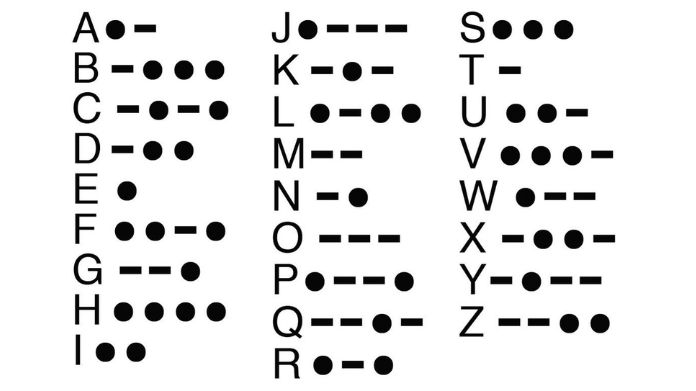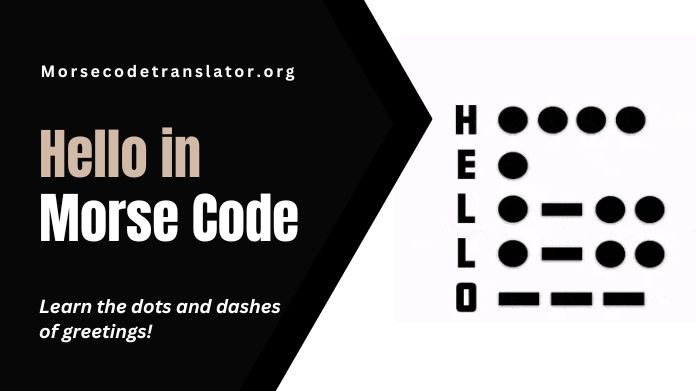People are still fascinated by the early 19th-century communication system known as Morse Code. This extensive guide contains all the information you require, whether you’re a history buff, a ham radio operator, or want to know how to say hello in Morse Code.
We’ll review Morse Code step-by-step, covering everything from the fundamentals to more complex ideas. When you finish reading this Morse code translator guide, you’ll understand this well-known form of communication better than just knowing how to say hello in Morse Code.
So, let’s get started!!
What is Morse Code?

Using a series of dots and dashes (or short and long signals) to represent letters, numbers, and symbols, Morse Code is a text transmission method.
It was created in the 1830s by Alfred Vail and Samuel Morse, and it was essential to long-distance communication, especially telegraphy.
In the past, telegraphy and maritime communication were two common uses for Morse Code, and it’s still useful in some situations today, including amateur radio operations, aviation, and emergency communication.
People intrigued by its extensive history and practical applications find themselves enthralled with this singular and historic mode of communication.
Components of Morse Code
Dots (.) and Dashes (-): These are the fundamental Morse Code building blocks, dots (.) and dashes (-). Dashes are longer signals than dots, which are shorter ones.
Letters and Numbers: A distinct set of dots and dashes symbolises each letter and number. For instance, “.-” stands for the letter “A” and “-…” for the letter “B”.
Word Spaces: Longer spaces are used to divide words, while word spaces are used to separate letters within words. They aid in making individual Morse Code characters and words more accessible to distinguish.
How to Say Hello in Morse Code?

To say “Hello” in Morse Code, you must know what each letter represents. The summary is as follows.
- H: ….
- E: .
- L: .-..
- O: —
So, “Hello” in Morse Code is “…. . .-.. .-.. —.”
Pronouncing Morse Code
Usually, Morse Code is communicated by sound, where dots are represented by short signals and dashes by longer signals. You can use various tools to transmit Morse Code, including a flashlight, telegraph key, and sound signals.
How to Learn Morse Code?
Here are the steps to Learning Morse Code Manually and with Apps and Resources.
Alphabet and Numeric: To begin, commit the alphabet and numeric representations to memory in Morse Code. Charts and internet resources are available to assist you with this.
Practice: Mastering Morse Code requires consistent practice. To get better, write and decode messages more often.
Use Online Resources: You can learn Morse Code using the numerous online resources and applications.
Mobile Apps: Numerous smartphone apps teach users Morse Code through interactive lessons and tests.
Online Courses: Many websites provide structured lessons and exercises in Morse Code for free.
YouTube Tutorials: With many video tutorials and demonstrations, YouTube is an invaluable tool for learning Morse Code.
Frequently Asked Questions
Q. Is Morse Code Still Used Today?
Ans. Indeed, there are still applications for Morse Code in amateur radio, aviation, and emergency communications. For certain radio operators, it is still a necessary ability.
Q. How Fast Can Morse Code Be Transmitted?
Ans. Skilled Morse Code operators can send up to 20 words per minute, if not more quickly.
Q. Can Morse Code Be Used for Secret Communication?
Ans. Even though Morse Code isn’t often used for secrecy, it can still be a quick and easy way to communicate discreetly if needed.
Q. Are There Any Famous Morse Code Messages in History?
Ans. The most well-known Morse Code message is “SOS,” a worldwide distress signal. When the Titanic sank in 1912, people famously used Morse Code to request assistance.
Conclusion
An enduring and distinctive communication technique that has made a lasting impression on history is the Morse Code. The fascinating journey into this world of dots and dashes doesn’t end with learning to say hello in Morse Code.
There are many reasons why people are drawn to and fascinated by the Morse Code, including its practical uses and historical significance.
So go ahead and begin studying Morse Code; before long, you’ll be able to greet people in a tongue encompassing centuries of innovative communication.
